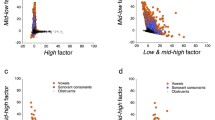Abstract
Frequency characteristics of electromyographic traces from the tongue and lips were studied as a function of class of phonemic input. Previous research has established that there are amplitude increases in the lips while processing bilabial linguistic units such as [p] and in the tongue when processing lingual-alveolar units (like [t]). Preliminary results using variability measures suggest similar conclusions for frequency parameters.
Similar content being viewed by others
References
McGuigan, F. J.Cognitive Psychophysiology—Principles of Covert Behavior. Englewood Cliffs, NJ: Prentice-Hall, 1978
McGuigan, F. J.Psychophysiological Measurement of Covert Behavior—A Guide for the Laboratory. Hillsdale, NJ: Lawrence Erlbaum Associates, 1979.
McGuigan, F. J., and Winstead, C. L., Jr. A discriminative relationship between covert oral behavior and the phonemic system in internal information processing.Journal of Experimental Psychology, 1974,103, 885–890.
Author information
Authors and Affiliations
Additional information
Appreciation is expressed to Brad Davis and Jeff Kadlac for assistance in the initial stages of this work, primarily with programing for the Fast Fourier Transform.
Rights and permissions
About this article
Cite this article
McGuigan, F.J., Dollins, A., Pierce, W. et al. Fourier analysis of covert speech behavior. Pav. J. Biol. Sci. 17, 49–52 (1982). https://doi.org/10.1007/BF03003476
Issue Date:
DOI: https://doi.org/10.1007/BF03003476




